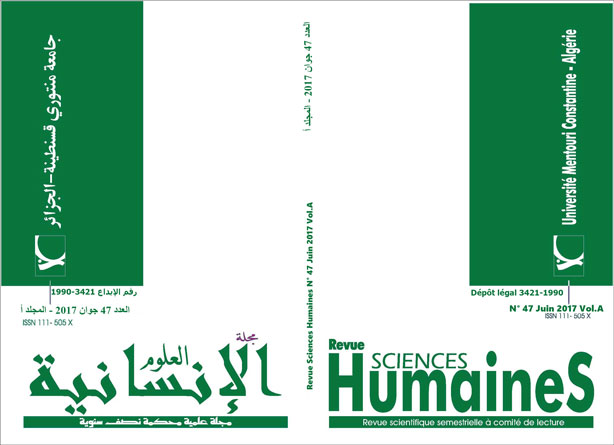RETHINKING THE LECTURING MODE IN HIGHER EDUCATION: A FOCUS GROUP STUDY
Mots-clés :
RETHINKING, LECTURING MODE, HIGHER EDUCATION, FOCUS GROUP STUDYRésumé
Lecturing still remains today the most common form of teaching in Higher Education notwithstanding its critics. Giving lectures has both strengths and limitations. This paper reports on the outcomes of a study that investigates the lecturing mode at the English Department, Oum El Bouaghi University, Algeria. The focus group method is used to characterize lecturers’ principles, practices and challenges, and students’ views, worries and aspirations. Techniques are eventually suggested to make lectures a true learning experience for foreign language learners.Téléchargements
Références
- Atkinson, M. (2004). Lend me your ears: All you need to know about making speeches and presentations. London: Vermilion.
- Benjamin, L. T., Jr. (2002). Lecturing. In S. F. Davis & W. Buskist (Eds.) The teaching of psychology: Essays in honor of Wilbert J. McKeachie and Charles L. Brewer (pp. 57–67). Mahwah, NJ: Lawrence Erlbaum Associates, Inc.
- Bligh, D. (2000a). What’s the point in discussion? Exeter, England: Intellect Press
- Bligh, D. (2000b). What’s the use of lectures? (5th. ed.), San Francisco, CA: Jossey-Bass Publishers.
- Boud, D., Cohen, R. & Sampson, J. (Eds). (2001). Peer Learning in Higher Education: Learning from and with each other. London : Kogan Page.
- Brown, G., & Manogue, M. (2001). AMEE Medical Education Guide No. 22: Refreshing lecturing: A guide for lecturers. Medical Teacher, 23(3), 231-244. DOI:10.1080/01421590120043000
- Brown S. & P. Race. (2002). Lecturing: A practical guide. London: Kogan Page Limited.
- Cashin, W. E. (2010). Effective Lecturing. IDEA PAPER,46. Manhatten, Kansas: The IDEA Center.
- Cox, B. (1994). Practical pointers for university teachers. London and New York: Kogan Page Limited.
- Goss Lucas, S., & Bernstein, D. A. (2005). Teaching psychology: A step by step guide. Mahwah, NJ: Lawrence Erlbaum Associates, Inc.
- Harmer, J. (2007). The Practice of English Language Teaching (4th ed.). England: Pearson Education Limited.
- Hartley, J., & Davies, I. K. (1978). Note taking: A critical review. Programmed Learning and Educational Technology, 15, 207–224.
- Haynes, A. & Haynes, K. (2012). 53 Interesting things to do in your lectures. London: Professional and Higher Partnership.
- Hedge, T. (2000). Teaching and Learning in the Language Classroom. Oxford: Oxford University Press.
- Hennink, M.M. (2007). International focus group research: A handbook for the health and social sciences. Cambridge: Cambridge University Press.
- Huxham M. Learning in lectures: Do interactive windows help? (2005). Active Learning in Higher Education, 6 (1), 17-31. SAGE Publications. DOI: 10.1177/1469787405049943
- Jordan, R. R. (1997). English for Academic Purposes: A guide and resource book for teachers. Cambridge: Cambridge University Press.
- Johnson, K. E. (1995). Understanding communication in second language classrooms. Cambridge Language Education. Cambridge: Cambridge University Press.
- Laurillard, D. (2002). Rethinking university teaching: A conversational framework for the effective use of learning technologies (2nd ed.). London and New York: Routledge Falmer.
- Legutke, M. & Thomas, H. (1991). Process and experience in the language classroom. London: Longman Group UK Limited.
- Liamputtong, P. (2011). Focus group methodology: Principle and practice. Sage Publications Ltd.
- McKeachie, W. J. (with chapters by Chism, N, Menges, R, Svinicki, M, and Weinstein, C E). (1994). Teaching tips: Strategies, research and theory for college and university teachers. Lexington, MA: D C Heath.
- Mejias, L. (2012). Effects of introducing an interactive teaching and learning activity (TLA) in the engineering classroom. Proceedings of the 7th ICCSE 2012, 1520 - 1525, IEEE, Sebel Albert Park, Melbourne, Vic. DOI: 10.1109/ICCSE.2012.6295353
- Murray, J. P. & Murray, J. I. (1992). How do I lecture thee? College Teaching, 40(3), 109-113. Taylor & Francis, Ltd.
- Race, P. (2015). The lecturer’s toolkit: A practical guide to assessment, learning and teaching (4th ed.). London and New York: Routledge.
- Ramsden, P. (1992). Learning to teach in Higher Education. London: Routledge.
- Richards, J. C. & Lockhart, C. (1996). Reflective teaching in second language classrooms. Cambridge: Cambridge University Press.
- Sander, P. (2005). Researching our students for more effective university teaching. Electronic Journal of Research in Educational Psychology, 5-3 (1), 113-130.
- Scevak, J., Southgate, E., Rubin, M., Macqueen, S., Douglas, H., & Williams, P. (2015). A guide for educators in Higher Education: Responding to diversity for positive academic outcomes. NCSEHE, Curtin University. Retrieved from: https://www.ncsehe.edu.au/wp-content/uploads/2015/10/Guide-for-Educators-in-Higher-Education.pdf
- Van Dijk L. A. & Jochems, W. M. G. (2002). Changing a traditional lecturing approach into an interactive approach: Effects of interrupting the monologue in lectures. International Journal of Engineering Education, 18(3), 275–284.
















